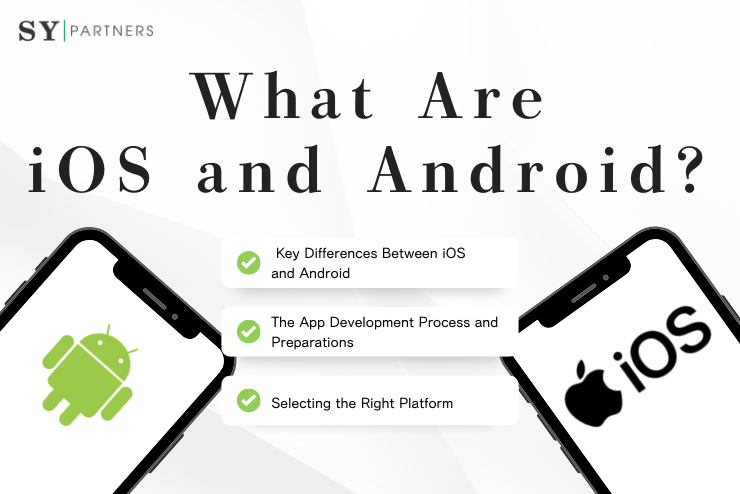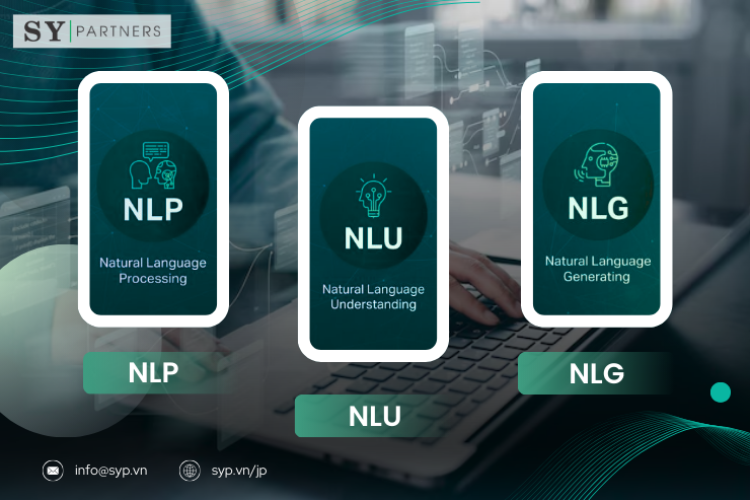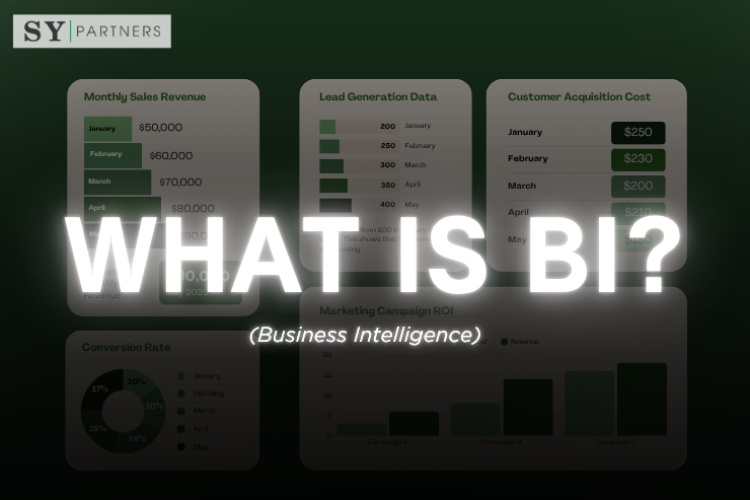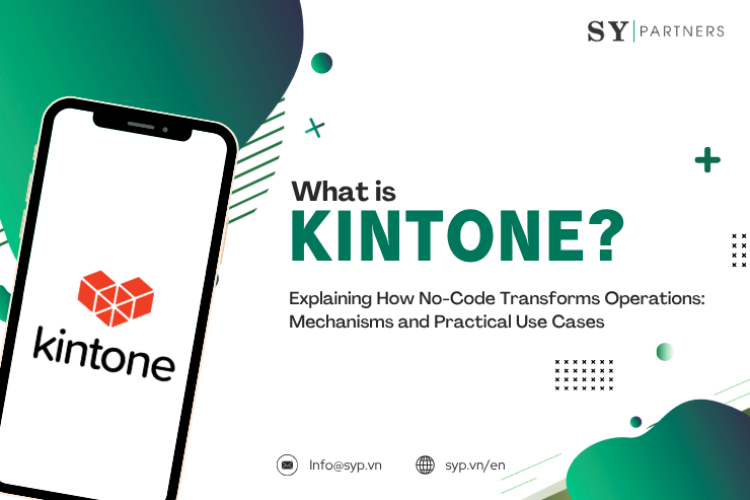What Are the Differences Between iOS and Android? Features of App Development and How to Get Started
The smartphone app market continues to expand as both individuals and large enterprises enter the field, making it a central driver of the digital economy. Among the key platforms, iOS and Android each offer distinct characteristics and development environments, requiring developers to adopt different approaches.
This article provides an easy-to-understand explanation of the differences between iOS and Android, even for beginners. We will compare aspects such as development languages, tools, review processes, and market characteristics. In addition, we will introduce various development options—including native, cross-platform, and PWA approaches—as well as efficient development methods leveraging AI technologies. This guide is designed as a practical first step for both companies and individuals considering app development.
1. What Are iOS and Android?
1.1 What Is iOS?
iOS is the mobile operating system developed by Apple Inc. Its key characteristics can be summarized as follows:
- Operates on Apple devices such as iPhone, iPad, Apple Watch, and iPod Touch.
- Strongly supported by high-income and brand-conscious user segments, with particular popularity in advanced markets like Japan, North America, and parts of Europe.
- Applications are distributed exclusively through the App Store, with a strict review process that maintains high quality standards.
iOS is notable for its integration within Apple’s ecosystem, offering refined design and robust security. For example, recent updates such as the iPhone 16 and iOS 18 further enhance user experience through seamless usability and ecosystem connectivity.
1.2 What Is Android?
Android is the open-source mobile operating system developed by Google. Its key characteristics can be summarized as follows:
- Runs on a wide range of devices from manufacturers such as Samsung, Sony, Xiaomi, Oppo, and many others.
- Widely adopted by a global user base, with particularly high penetration rates in emerging markets and regions where affordable smartphones dominate.
- Applications are distributed through Google Play, where the review process is more flexible compared to Apple’s App Store.
Android’s strengths lie in its high customizability and support for a diverse array of devices. For example, Samsung Galaxy’s One UI provides a unique user experience tailored to its ecosystem.
2. Key Differences Between iOS and Android
iOS and Android differ in many aspects, ranging from development languages to market characteristics. The following comparison, organized into subheadings and a reference table, provides a detailed explanation.
2.1 Development Languages
- iOS: The primary development language is Swift, created by Apple. Swift is beginner-friendly, allows developers to write fast and secure code, and supports modern UI development through SwiftUI, which enables intuitive interface design. While Objective-C is still used for legacy projects, Swift has become the mainstream language.
- Android: The recommended language is Kotlin, endorsed by Google for its concise and safe coding style. Java remains widely used, especially in older or enterprise applications.
AI tools such as GitHub Copilot can support both Swift and Kotlin, offering code completions that ease the learning curve for beginners. For instance, when designing an iOS app interface with Swift, AI can suggest code snippets that help reduce development time.
2.2 Integrated Development Environments (IDE)
- iOS: Development is done using Xcode, Apple’s official IDE, available exclusively on macOS. It provides rich support for SwiftUI and device simulators, allowing even beginners to work intuitively. For example, Xcode’s live preview feature enables developers to check UI changes in real time.
- Android: The standard IDE is Android Studio, which supports Kotlin, Java, and XML. It provides emulators for a wide range of devices and offers flexibility for cross-platform development. AI-powered features within IDEs further streamline code completion and debugging.
2.3 Review and Publishing Process
- iOS: Publishing apps on the App Store requires passing a strict review process that checks UI/UX, security, and adherence to Apple’s guidelines. The process can take 1–2 weeks. AI-driven automated testing tools (e.g., Testim) help detect bugs, verify compliance, and improve approval rates.
- Android: The Google Play review process is more flexible, often allowing apps to be published within a few hours to a few days. However, due to the wide variety of devices, device-specific testing is essential. AI testing solutions can help reduce the workload by automating multi-device compatibility checks.
2.4 Market Characteristics
- iOS: The App Store is known for high-quality apps and users with strong willingness to pay. In many advanced markets (e.g., Japan, the U.S., Europe), subscription-based apps and mobile games generate significant revenue.
- Android: Google Play hosts a larger number of apps and offers stronger global reach, particularly in emerging markets. Free apps dominate, and ad-based business models are common. AI-driven design tools (e.g., Canva) can be used to efficiently create promotional materials such as app banners.
2.5 Revenue Models
- iOS: Revenue is primarily driven by paid apps and in-app purchases. In markets with strong iOS user bases, such as Japan and North America, consumers are more likely to pay for premium features. For example, mobile games often achieve high earnings through in-app purchases.
- Android: Revenue relies heavily on advertising and the freemium model. In emerging markets where demand for free apps is high, monetization is maximized through ad optimization platforms like Google AdMob.
2.6 Customizability
- iOS: Apple’s closed ecosystem limits customization. This creates a consistent user experience across devices, ensuring brand coherence and stability.
- Android: As an open-source platform, Android allows device manufacturers and developers to freely customize the system. For instance, Samsung’s One UI delivers a distinct visual experience. AI tools can further support rapid prototyping of custom UI designs.
2.7 Device Variety
- iOS: Limited to Apple devices such as the iPhone 16 and iPad Pro. The small number of device types makes testing and optimization more manageable.
- Android: Runs on a wide range of devices from manufacturers such as Samsung Galaxy and Xiaomi 14, among many others. AI-powered automation tools (e.g., Appium) reduce the burden of testing across this diverse ecosystem.
3. App Development Options
When developing an app, it is crucial to select the most suitable development approach based on your objectives, budget, resources, and target user base. Three primary methods are widely adopted. By understanding the characteristics, advantages, and disadvantages of each, businesses and developers can make more informed and rational choices.
3.1 Native App Development
Native app development refers to building apps for iOS and Android separately, using their respective programming languages and development environments.
Features and Advantages
- High performance: Because native apps interact directly with the OS and hardware, they offer fast processing speeds and high stability. They can fully leverage device-specific features such as cameras, GPS, and accelerometers.
- Optimized user interface: iOS apps can be built with SwiftUI, while Android apps use Material Design, ensuring a UI optimized for each platform.
- Superior user experience: Smooth animations and quick responsiveness deliver intuitive, stress-free interaction.
Best-Suited Use Cases
- Graphics-intensive mobile games
- Financial apps requiring high security and responsiveness
- Enterprise apps that heavily rely on device functionality
For projects where quality and user experience are top priorities, native app development is the most reliable choice.
3.2 Cross-Platform Development
Cross-platform development is an approach that allows developers to create a single codebase that runs across multiple platforms, primarily iOS and Android.
Features and Advantages
- Increased efficiency: Frameworks such as Flutter (Dart), React Native (JavaScript), and Xamarin (C#) enable multi-platform deployment from one implementation.
- Cost reduction: Unlike native apps, there is no need to write separate codebases, which lowers development costs and man-hours.
- Maintainability and scalability: A unified codebase simplifies updates and bug fixes, making this approach well-suited for long-term projects.
Best-Suited Use Cases
- Startups seeking to minimize initial costs
- Projects where speed-to-market is critical
- Business or informational apps with simple UI/UX
Example Tools
AI-powered development tools such as FlutterFlow can accelerate UI design and logic implementation with low-code or no-code approaches, further improving efficiency.
If your goal is to balance development cost and delivery speed, cross-platform development provides an excellent middle ground.
3.3 PWA (Progressive Web App)
Progressive Web Apps (PWA) use web technologies such as HTML, CSS, and JavaScript to deliver an experience similar to native apps. They run in mobile browsers while offering app-like visuals and interactions.
Features and Advantages
- No installation required: Users can access the app directly from their browsers without going through the App Store or Google Play. PWAs can be bookmarked or added to the home screen for easy access.
- No app store review: Since PWAs don’t require store approval, updates and changes can be reflected immediately, allowing for flexible operations.
- Lower development and maintenance cost: A single web app can serve multiple operating systems, reducing platform-specific costs.
Limitations and Considerations
- Restricted access to device features: Some hardware functionalities such as cameras, Bluetooth, biometric authentication, and push notifications may be limited compared to native apps.
- Offline support requires careful design: Features like Service Workers for cache control demand more advanced implementation in certain scenarios.
Best-Suited Use Cases
- Product catalogs or news distribution apps
- Small to medium-scale e-commerce sites
- Lightweight business tools that don’t require user registration
When functionality requirements are limited but ease of use and low cost are top priorities, PWAs are often the most rational choice.
4. The App Development Process and Preparations
App development is not just a technical task—it requires a clear purpose and a structured, step-by-step process. From planning and design to development, testing, release, and ongoing improvement, each stage is interconnected, and none can be overlooked.
This section breaks down the app development process into five beginner-friendly phases.
4.1 Planning and Design
The initial phase—planning and design—lays the foundation for the entire project. If goals are unclear or user needs are poorly defined, later stages may face costly rework.
- Target definition: Identify your audience (e.g., age, gender, purpose, region). A teen-focused social app may prioritize intuitive navigation and notifications, while apps for the Japanese market benefit from an iOS-first approach.
- Requirements gathering: List and prioritize necessary features (login, push notifications, search, payments, chat, etc.). AI tools (e.g., ChatGPT) can support brainstorming and user-centered feature validation.
- Wireframing: Use Figma or Adobe XD to design screen flows and layouts. Keep the UI simple and intuitive. AI-powered plugins in Figma can help accelerate the design process.
A well-defined vision of the target users, essential features, and UI framework ensures a smooth progression throughout development.
4.2 Setting Up the Development Environment
Once the concept and requirements are finalized, the next step is to prepare the technical environment.
- For iOS: Use Xcode, Apple’s IDE for macOS, which includes SwiftUI, Storyboard, and device simulators. An Apple Developer Program subscription (USD 99/year) is required for publishing.
- For Android: Install Android Studio, compatible with Windows, Mac, and Linux. It includes powerful emulators for multi-device testing.
- AI-powered support: Tools like GitHub Copilot automate boilerplate setup, suggest templates, and fix syntax errors, reducing both learning curve and setup time.
Properly preparing the environment ensures a smoother development phase.
4.3 Coding
This is the most critical phase where design becomes functionality.
- Languages: Swift (iOS) and Kotlin (Android) are modern, secure, and developer-friendly. AI assistance boosts productivity with auto-completions, debugging, and code snippets.
- UI/UX implementation: Follow Apple’s Human Interface Guidelines (iOS) and Google’s Material Design (Android). Pairing design tools with AI plugins enables high-quality UI creation quickly.
- Database & API integration: Use services like Firebase for real-time features such as login, chat, and product listings.
By balancing quality, scalability, and efficiency, you create apps that are both user-friendly and developer-maintainable.
4.4 Testing
No app should be released without thorough testing.
- Device & emulator testing: iOS testing is simpler due to limited device variations, while Android requires broader compatibility checks. AI testing frameworks like Appium and Testim streamline cross-device testing.
- Functional testing: Verify login, payments, notifications, and other essential workflows.
- Performance testing: Conduct stress tests and loading time checks to ensure smooth performance.
Robust testing builds reliability and user trust.
4.5 Deployment and Maintenance
After successful testing, the app is ready for release—but launch is just the beginning.
- Submission & review: Apple App Store reviews are stricter and may take 1–2 weeks, while Google Play approvals often finish within hours to days. AI-generated assets can simplify submission.
- Monitoring & updates: Use tools like Firebase Analytics to track usage and crashes, and update apps regularly to fix bugs and improve features.
- Marketing & promotion: Leverage social media, ads, and design tools like Canva to create attractive promotional materials.
Sustained growth comes from continuous improvement, user engagement, and effective promotion.
5. Which Should You Start With? Key Points for Choosing
Deciding whether to start app development with iOS or Android depends on your business goals, target market, and development resources. Below are four perspectives to help guide your choice.
5.1 Based on Target Market
The platform you should prioritize largely depends on user demographics and region.
For example, in Japan, iOS has a strong market share and users tend to have a higher willingness to pay. This makes iOS an effective starting point for subscription-based apps or mobile games.
On the other hand, in emerging markets such as Southeast Asia or South America, Android dominates. It aligns well with free apps and ad-driven business models. Leveraging AI-powered market analysis tools (e.g., Perplexity) can help efficiently research such market trends.
5.2 Budget and Development Resources
Native development delivers high-quality, high-performance apps but requires maintaining separate codebases for iOS and Android, which increases costs and effort.
By contrast, cross-platform frameworks like Flutter allow you to build for both platforms from a single codebase, making it easier for small teams or limited budgets.
Additionally, AI tools like GitHub Copilot can help optimize development costs by automating code generation and debugging.
5.3 Speed to Market
If speed is your priority, starting with Android may be advantageous. Google Play’s review process is relatively fast, with apps often published within hours to a few days.
In contrast, iOS has stricter review guidelines, and approval may take one to two weeks. Incorporating AI-powered automated testing tools can streamline the validation process on both platforms, reducing overall development time.
5.4 Scalability and Future Expansion
From a long-term perspective, each platform’s ecosystem and integration potential should also be considered.
iOS provides seamless connectivity with Apple Watch, Mac, and other Apple devices, making it suitable for lifestyle-focused apps.
Meanwhile, Android is more adaptable to IoT devices, automotive systems, and industrial applications, offering strong scalability in B2B contexts. AI-powered prototyping and strategic planning tools can further support decisions aligned with long-term goals.
6. Conclusion
iOS stands out with its polished development environment using Swift and Xcode, while Android offers flexibility and multi-device support through Kotlin and Android Studio. Whether you choose native development, cross-platform frameworks, or PWA, understanding the full development flow from planning to release is key to success—even for beginners.
With AI accelerating code generation, UI design, and automated testing, development efficiency is rapidly improving. Start by choosing the platform that best matches your goals, take small steps forward, and use app development as a driver to grow your business.


 EN
EN JP
JP KR
KR




